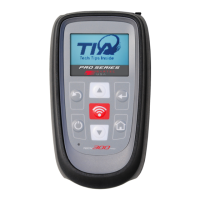Bartec USA TPMS PRO Series User Guide Rev5.1 Table of Contents
Page 52
12.0 Appendices
A - GLOSSARY
Audit Data is all the sensor and OBD data stored on the tool.
Bar units are commonly used in many Western European countries as a metric unit of pressure. 1 bar equals 100 kPa, or
approximately 14.5038 psi.
Bluetooth is a wireless technology standard for exchanging data over short distances from fixed and mobile devices.
Direct System is a TPMS that has RF sensors in the wheels.
Hi-Line or High-Line is a TPMS type that has wheel-mounted receivers, which can force periodic transmissions from each wheel
sensor to keep a continuously updated pressure status. Vehicles using hi-line TPMS usually have a graphic display in the dash.
Indirect System are the systems that do not have air pressure sensors inside the tires. Instead, they detect a low tire by
comparing relative wheel speeds via the Anti-Lock Brake System (ABS) wheel speed sensors.
Inductive Charging or Qi (also known as "wireless charging") uses an electromagnetic field
to transfer energy between two
objects. This is usually done with a charging station. Energy is sent through an inductive coupling to an electrical device, which
can then use that energy to charge batteries or run the device.
kPa (or kilopascal) is a metric unit of pressure measurement widely used throughout the world. 1 kPa equals approximately
0.145038 psi.
LF (Low Frequency) is the ITU
designation for radio frequencies in the range of 30 kHz–300 kHz, usually 125 kHz with respect to
TPMS technology.
Lo-Line or Low-Line is a TPMS type that uses a passive receiver to listen for sensor transmissions. Vehicles using low-line TPMS
usually have a simpler dash display (e.g. a single on/off/flashing TPMS warning light).
Mini USB (Universal Serial Bus) is a smaller, 5-pin cable connector that is used by various handheld electronic devices. It is often
used for both USB data connectivity as well as charging.
On-board diagnostics (OBD) is an automotive term referring to a vehicle's self-diagnostic and reporting capability. Modern OBD
implementations use a standardized digital communications port to provide real-time data in addition to a standardized series
of
diagnostic trouble codes (DTCs), which allow one to rapidly identify and remedy malfunctions within the vehicle.

